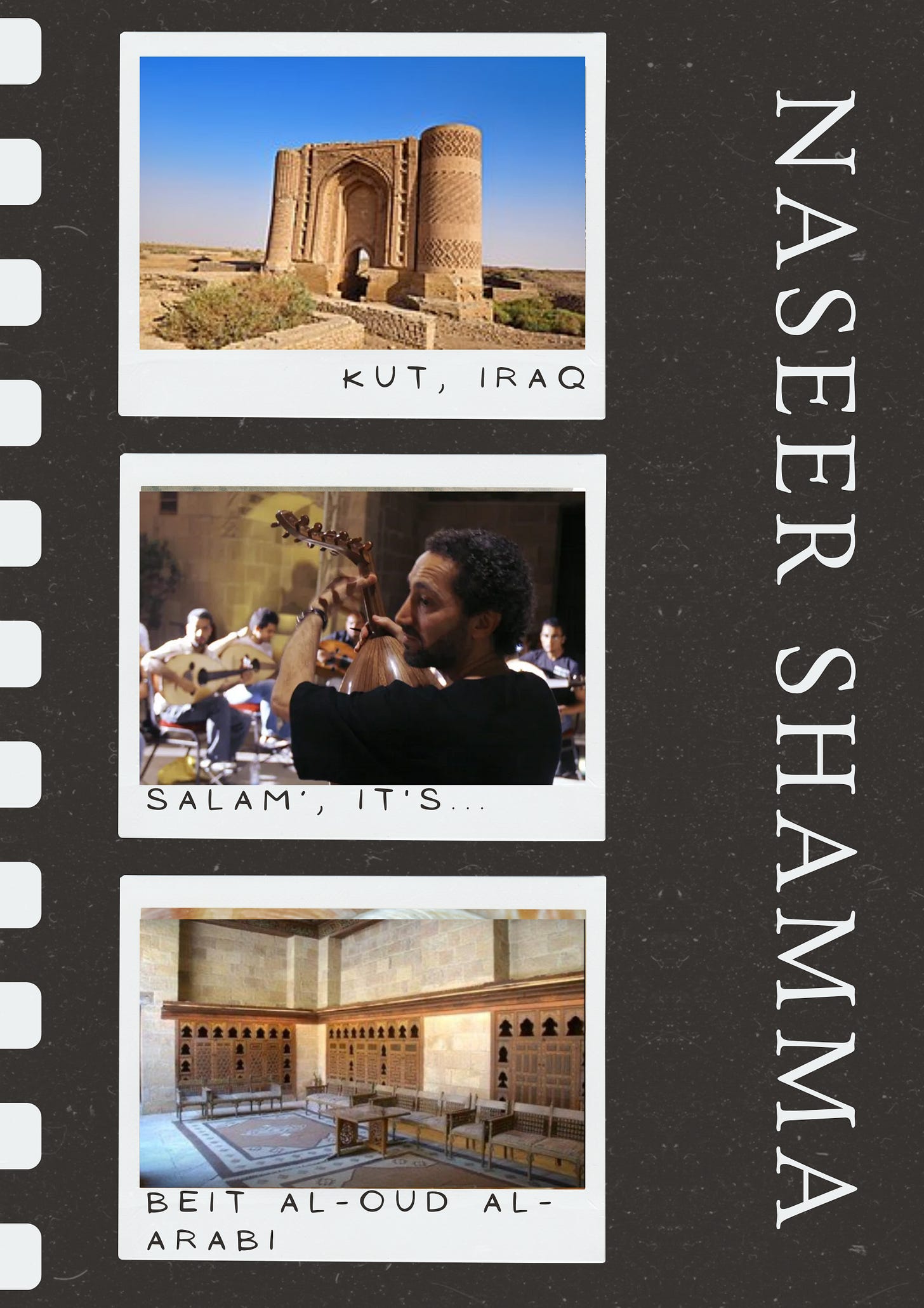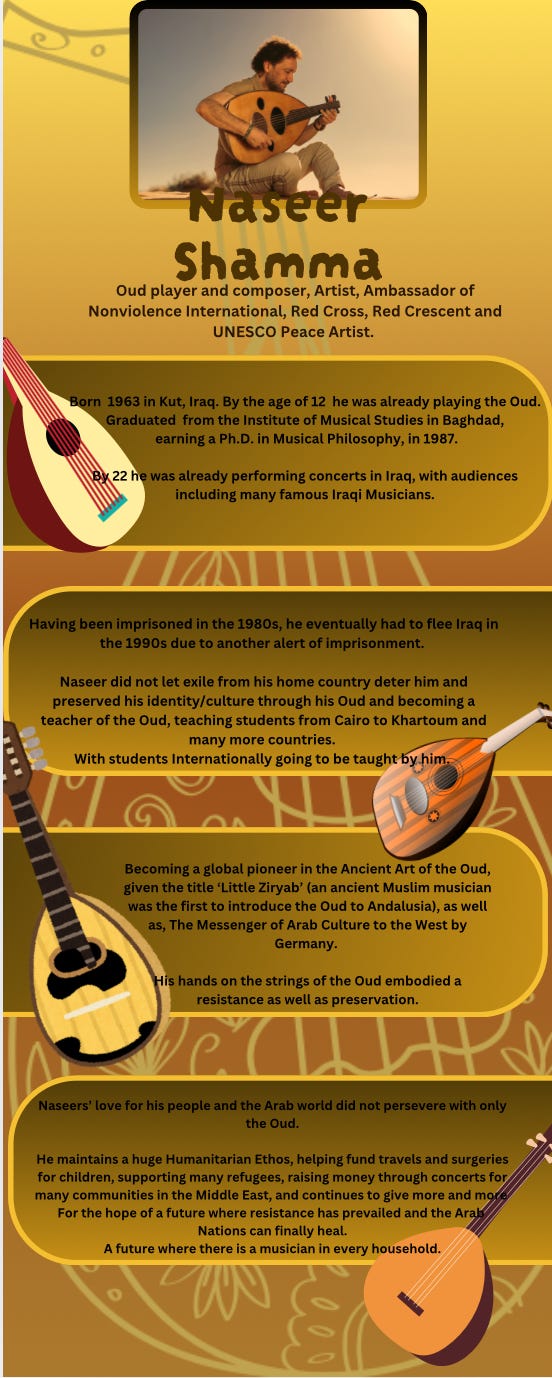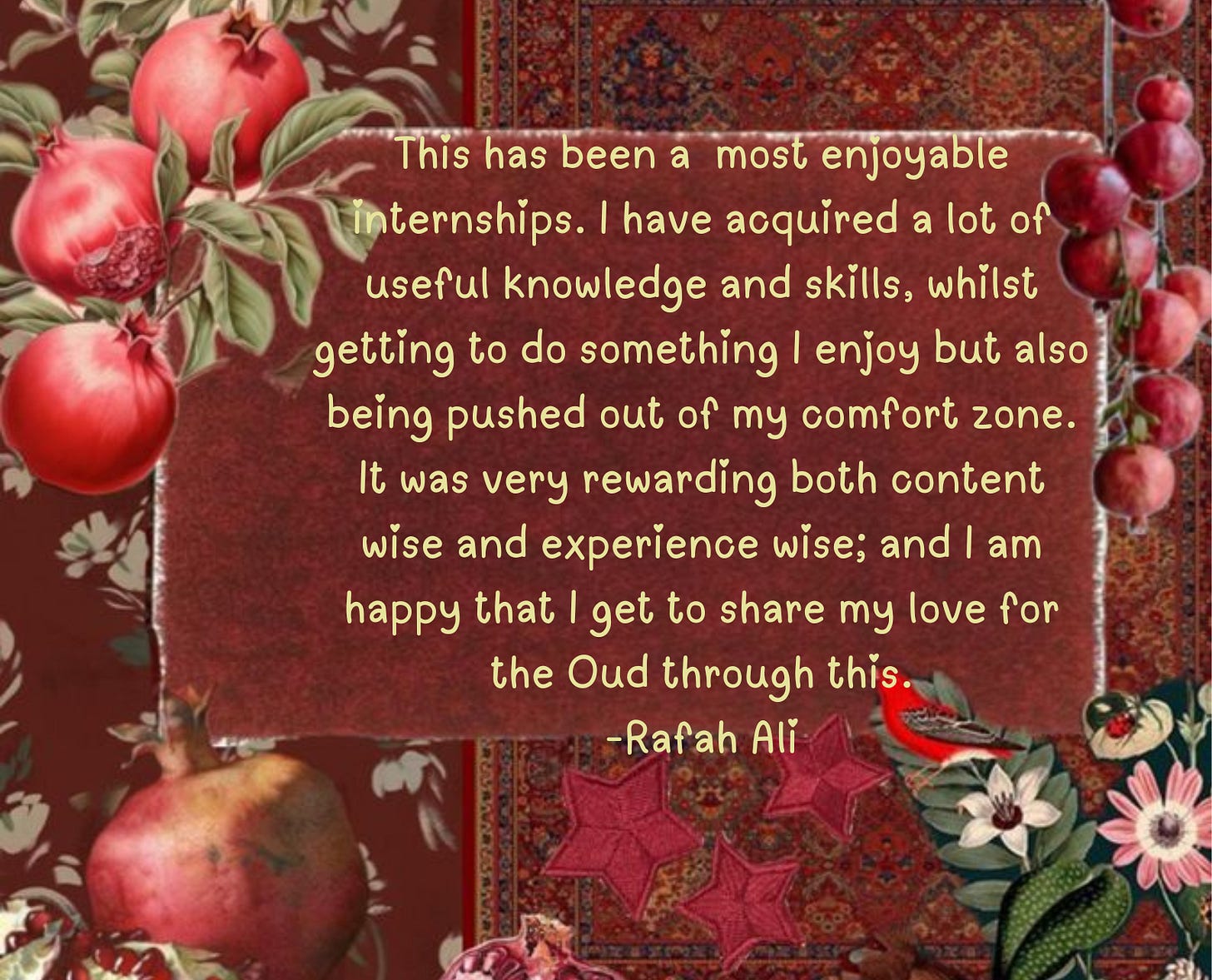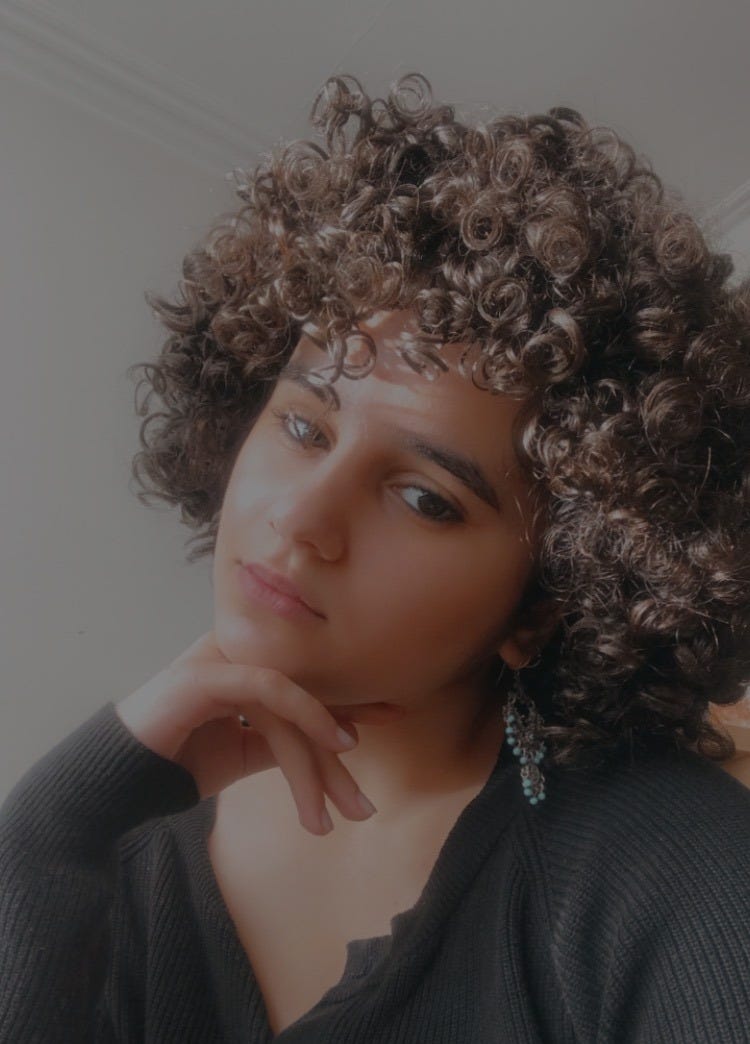4,000 Years of Sound: He Plays the Oud. He Rebuilt Culture, Note by Note 🪕
Play & learn about Nasser Shamma's arty refugee experience 🎮
Click here to play & learn.
Back Story
What do you believe people would need in post conflict communities? Food? Water? Housing? Security? Knowledge of the state of their loved ones? These are all of course necessities for communities in any state, but especially in post conflict communities, these are even more so necessary. However, one constant necessity that is often overlooked in communities in all three states: before, during and after, is the cultural heritage. Cultural heritage can manifest itself in many different ways: music, art, cooking, dancing, singing, farming and agriculture, clothing etc. There is an indefinite list. It is the cultural heritage of these communities that changes their status in a post conflict environment from ‘surviving’ to ‘living and wanting to thrive’. It is in this way that the forms of ‘Cultural Heritage ’embodies and showcases the resilience and perseverance of a people.
You can see this in many instances. For example, during Pro-Palestinian protests there are many people who dance the ‘dabke’ (a traditional Palestinian dance, which is shared, with slight differences, with the other Levant countries), or wear the black and white Keffiyeh which has become a symbol of resistance in the past 80 years; nurturing and bringing back to life the very earth one steps on with agricultural (farming) methods passed down through generations etc. One notable Iraqi artist named Layla Al- Attar (1942-1993) portrayed her resistance through her art; she created a mosaic portrait of George H. W. Bush on the floor of the main entrance of Al Rasheed Hotel with the phrase “Bush is Criminal“ written beneath it (which allowed people to step on his face when they walked in and out the entrance). She continued to create her art and never strayed from politics, with her main focus being the importance of women in all spheres of society.
Having developed an understanding of cultural heritage, we will now look at the main subject of this article: Naseer Shamma. Born in 1963, Kut, a city in the south of Iraq on the Tigris river, Naseer Shamma as a young boy developed a love for the Oud. The Oud (you might also know it by the name: Lute) is a stringed instrument, known as the grandfather of all stringed instruments, because the Oud is an ancient instrument with ancient musical traditions dating more than 4,000 years to Mesopotamia. The Oud ended up being introduced to new countries and continents, of which all ended up developing their own version of it; we also know that the Oud was introduced to Andalusia (modern day Spain) by Ziryab, who was an Iraqi singer and musician from Mosul (a city in Iraq) in the 9th century AC. Later on in life Naseer Shamma would be given the title “Little Ziryab,” from France, and the title of Messenger of Arab Culture to the West from Germany. In his replies to questions from the Chicago Symphony Orchestra, Naseer states that he also sees himself as a student of Ziryab, stating:
‘’During Ziryab’s time, he was transferring our rich civilization from the East to the West. He was a messenger who wandered and left his disciples everywhere. I am also, in a way, one of his students, and my work on the oud is also globalizing.’’
However, the journey to gain these titles was a turbulent one, and Naseer remained steadfast in his wish to preserve the ancient musical tradition of the Oud. As a young man, he went on to graduate from the Institute of Musical Studies in Baghdad, as well as earning a Ph.D. in Musical Philosophy, with his research focus being on musical stylistics, which was not a common study in Arab libraries. Explaining his research focus to the Chicago Symphony Orchestra, Naseer states: ‘’My research deals with Chopin’s influences on music and writing for the piano, and also includes stylistic theory and how it applies to music and to Arab and European composers.’’
Naseer approached the Oud as an individual, whilst following in the footsteps of those who came before him with respect, he also found his own path with the Oud, and his many contributions will become evident of this.
Firstly we must look at his life in Iraq and his eventual need to leave the country. Iraq in the 1980s to 2000s was not a very stable country, from problems arising both internally and externally. Now under the Saddam Hussein regime, Naseer Shamma was arrested under the claim that he had insulted the regime, however, there was no fair trial and not much to the case yet he was sentenced to be executed without court hearing, after a few weeks of interrogating. He spent several weeks in prison before they just let him go without any due processing. Naseer remained in Iraq even after this, but it was during the 1990s when the USA was creating great devastation in Iraq, that someone alerted Naseer that another imprisonment was imminent which led him to flee Iraq into exile.
Despite his flee from his beloved country, he remained carrying that country around with him in the form of his Oud. He became a teacher and kept the tradition alive by teaching others. Eventually Naseer Shamma went on to create multiple music schools across the Middle East called Beit al-Oud al-Arabi or The Arab Oud House; with many people globally seeking him out as a teacher due to his unique style when playing the Oud.
Truly as a knight wields his sword, Naseer wields his Oud. He not only protects this musical tradition but also defends and fights for his people. Wielding a huge humanitarian ethos, he donates concert proceeds to pay for medical care and schooling for refugees and lobbies Arab governments to offer aid. Notably in 2008 he raised 24,000 USD for UNHCR's (United Nations High Commissioner for Refugees) Iraqi refugee programme with a concert in Damascus.
Naseer now holds the titles of Ambassador of Nonviolence International, Red Cross, Red Crescent and UNESCO Peace Artist. Even in exile he does not stop providing for his community and his people, continuously waiting for a day where his nation is truly free and healed. These feelings of hope but despair, longing but pain, a life of exile is very evident in his music, with Naseer commenting:
"You know it's more deep, my music, and more strong now, because always there is pain everywhere ... and in my heart. And, of course, all that is very clear in my music,"
His music is not a form of escapism, rather a resilient and steadfast approach to reality. Both the reality that he lived and the reality that many Iraqis are living.
One of the most amazing things that Naseer has done, that truly cemented him as an Oud master who deserves the respect of many, is the development of a way to play the Oud with one hand. From a friend who emerged from the Iraq-Iran war with only one hand, to a vast majority of adults and children alike who lost hands and fingers during conflicts or as punishments; Naseer Shamma made what seemed impossible, possible (keeping his promise to his friend):
"I stayed in my house for months without giving any concerts," ,"Every day I practiced, practiced, practiced. At the end of a month, I thought, 'This is impossible.' But in the end I did it. ... I kept my promise."
At the end of the day, what has always stuck with humanity for centuries, is an appreciation for the arts. It is what sets us aside from other animals. And it is this appreciation that will keep us going and remind us not to abandon our humanity. Naseer Shamma shows us how we can be a community that heals together through preserving culture.
Bibliography
Carmona, L. (n.d.). Ziryab, the amazing story of the singer from Baghdad. [online] El legado andalusi. Available at: https://www.legadoandalusi.es/magazine/ziryab-the-amazing-story-of-the-singer-from-baghdad-2/?lang=en.
Ibrahimicollection.com. (2025). Layla AL-ATTAR (1944 – 1993) | Ibrahimi Collection. [online] Available at: http://www.ibrahimicollection.com/node/114 [Accessed 28 Mar. 2025].
Kandel, D. (2022). The Empowering Legacy of Iraqi Artist Layla Al-Attar. [online] Arts Help. Available at: https://www.artshelp.com/layla-al-attar/.
KEYSER, J. (2008). Composer uses music to help Iraqis in need. [online] Sarasota Herald-Tribune. Available at: https://eu.heraldtribune.com/story/news/2008/09/15/composer-uses-music-to-help-iraqis-in-need/28661437007/ [Accessed 28 Mar. 2025].
Murphy, M.C. (2010). Naseer Shamma and the music of resistance. [online] The Electronic Intifada. Available at: https://electronicintifada.net/content/naseer-shamma-and-music-resistance/8662.
Naseer Shamma. (n.d.). Bio. [online] Available at: https://www.shammamusic.com/bio.
Sbeity, L. (2024). Naseer Shamma: The oud is a mirror that reflects the player’s emotions. [online] Al Majalla. Available at: https://en.majalla.com/node/320016/culture-social-affairs/naseer-shamma-oud-mirror-reflects-players-emotions.
Thomas, M. (2015). Oud master Naseer Shamma builds global harmony through music | Chicago Symphony Orchestra. [online] Experience the Chicago Symphony Orchestra. Available at: https://cso.org/experience/article/12152/oud-master-naseer-shamma-builds-global-harmon.
Wilkes, S. (2023). World Refugee Day: Iraqi musician raises USD 24,000 for UNHCR programmes | UNHCR UK. [online] UNHCR UK. Available at: https://www.unhcr.org/uk/news/world-refugee-day-iraqi-musician-raises-usd-24-000-unhcr-programmes [Accessed 28 Mar. 2025].
In this post Raffah highlights the arty refugee experience of Nasser Shamma. She is a citizen journalist on a placement with us organised by Oxford University Career Services. She also organised the micro game to make the journalistic experience interactive.
Thank you for reading an A4R 🎨 Post. Don’t forget to visit our gift shop here. Every purchase scales our impact and pays our bills.






